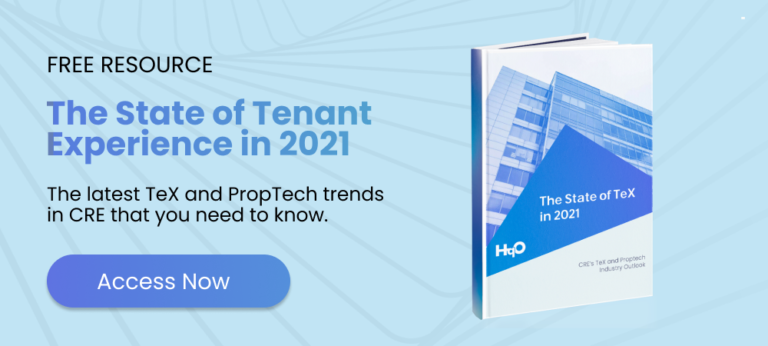As the office sector undergoes a complete digital revolution, the recent influx of technology partners in the market has also led to an influx in commercial real estate analytics. Now more than ever, we’re acknowledging the importance of data science in real estate — especially when it comes to the many benefits that data-driven decision making can bring to one’s portfolio. Such practices can help property teams collect important insights on their end-users, thus informing strategic property decisions that previously had been made with little or no data and increasing their property’s net operating income (NOI).
With so much change happening in the industry — and at such an accelerated pace — it has become a necessity for landlords to determine if their assets are prepared to adapt to the modern workforce and to become more competitive. Those who don’t adopt this mindset, and who don’t have a birds-eye view on the competitiveness of their properties and experiences, are bound to fall short of modern workplace expectations for their end-users.
With that in mind, how can commercial leaders make sure that their portfolios are set up to provide them with all the valuable information they need to succeed? Below are just three ways property teams can bring their buildings up-to-speed.
1. Activating Building Amenities
When it comes down to it, tech-enabled, highly amenitized buildings are the offices tenants want to come back to. A 2019 Cushman & Wakefield study revealed that before the COVID-19 pandemic, highly amenitized buildings had an 18.3% rent premium compared to the surrounding submarket. This premium proved even more substantial at 21.6% in the central business districts (CBDs) of gateway markets. Amenities still play a role in overall office culture, and the concept of flight to quality — or digitally enhancing your building’s offerings — can prove to be a major differentiator for your portfolio. This also lends credence to the positive impact that technology can have on cap rates when focused on engaging people and strengthening connections.
Fortunately, activating your building’s physical features and offerings can also be a source of some of the best real estate analytics. In order for landlords and property teams to discover their tenants’ actual experience with their building features, they need to collect and analyze a specific series of metrics that deeply explain tenant behavior and sentiment. For example, if you’re trying to assess your amenities, you may look at digital engagement (or clicks) with content/information on your amenities through your tenant app, tenants’ satisfaction with those amenities, mobile access data to those amenities, equipment sensor data associated with those amenities, class or service bookings, and so on. The more activations your building features have, the more data points you can combine to paint a more holistic picture of which amenities see the most traffic, which ones need improvement, and more — showing you how your building is actually being used.
2. Opting in to Deep Integrations
Once you start activating your building amenities, you also want to make sure that you’re accessing more than vanity metrics for your building. Truly unlocking actionable data and insights that go beyond the surface-level requires a single platform with rich, API-based integrations that tie together all aspects of the tenant experience. Without these deep integrations, the technology trail ends abruptly, leaving property owners with no additional information that they can apply to their assets.
As a part of this solution, investing in a platform that integrates mini apps is another critical differentiator to access key commercial real estate insights. Mini apps are a simple way for third-party experience providers to plug their apps into your tenant app, which enables teams to control distribution, create a one-stop-shop for tenants, and — most importantly — make sure you are collecting data on what people are doing in your buildings versus sending your users to external apps. For example, having a mini app for mobile access would be able to let property teams know exactly when and where employees have entered a building or given space through its plugged-in sensor technology, as well as detail their journeys throughout the building (depending on how many mobile sensors there are) and even more granular data.
3. Establishing Direct Lines of Feedback
The third source of valuable building information comes directly from your most important assets: your tenants. Through strategic digital programming initiatives — such as sending out frequent tenant surveys to ask them about what they enjoy at your building, what they don’t enjoy, and what they’d like to see more of through a tenant or property management app — you can establish a virtuous feedback loop. Having such significant intelligence on the end-user of your product helps create a better user experience, which in turn increases customer engagement and continues to provide you with more useful data. Real-time feedback ensures the longevity of office buildings by giving market leaders the informed, competitive edge they need to make turnkey decisions and guarantee customer satisfaction.
HqO clients, such as The Swig Company, have already begun to take advantage of their tenant experience platform’s surveying capabilities. For example, the Swig team has engaged its tenants with consistent surveys through its app to help determine what has been popular for tenants, what they want to hear more about, and more on a monthly basis. This has been especially crucial during the pandemic, aiding in the shift from in-person to virtual programming.
Organizing Your Data for Success
Finding meaningful metrics about your building can be few and far between — and even more difficult to organize. Luckily, the HqOS™ end-to-end operating system provides CRE owners with a leap in the right direction. The three layers of HqOS — which include our Marketplace, Tenant Experience Platform, and the Digital Grid™ — work seamlessly together to produce compounding positive results for any portfolio.
Our growing Marketplace of best-in-class technology partners and mini apps — which can be accessed through the Tenant Experience Platform — enables landlords to activate more of their building features, while simultaneously providing tenants with a better experience and property managers with a higher volume of rich data. The Digital Grid — which is our commercial real estate analytics software — then takes these activations a step further, serving as a connected and streamlined offering that can collect tenant behavior, amenities, technologies, and building data all in a single location.
By centralizing and structuring data within our CRE-specific data model, it helps owners and operators uncover insights, take action to differentiate their assets, and make intelligent decisions across their portfolio. It can also help contribute to your building’s predictive analytics, as well as to benchmark your portfolio’s performance against others to accelerate world-class experiences for any tenant population.
To learn more about how HqO can help you collect data on your buildings, download your free demo today.




